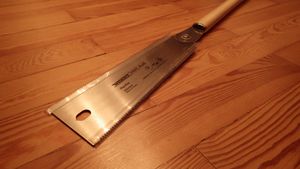Japanese Saws: Difference between revisions
From CoMakingSpace Wiki
NitramLegov (talk | contribs) m German |
NitramLegov (talk | contribs) m Location update |
||
| Line 9: | Line 9: | ||
|material=[[wood]] | |material=[[wood]] | ||
|used with= | |used with= | ||
|location=[[Location::Wood | |location=[[Location::Handheld Wood Tool Wall]] | ||
|access=read this page | |access=read this page | ||
|tutors=[[User:Lukas|Lukas]] | |tutors=[[User:Lukas|Lukas]] | ||
Revision as of 22:01, 29 August 2022
Japanese woodworking saws cut on the pull stroke, as opposed to "Western" ones that cut when you push. This allows the blade to be made extremely thin, but also makes it easier to accidentally bend it by pushing too much!
Ryoba
| ToolInfoBox Ryoba | |
|---|---|

| |
| Synonyms: | DE: "Japansäge" |
| Type: | hand saw |
| Material: | wood |
| Location: | Handheld Wood Tool Wall |
| Access Requirements: | read this page |
| Tutors: | Lukas |
A "Ryoba" has two cutting sides, one with hardened crosscutting teeth and one with simple larger teeth for quick cuts along the grain.
Our model seems to be compatible with both Bauhaus and Hornbach blades in case a replacement is needed.
Other Styles
- Dozuki: Japanese backsaw
- Kataba: similar to Dozuki, but no back